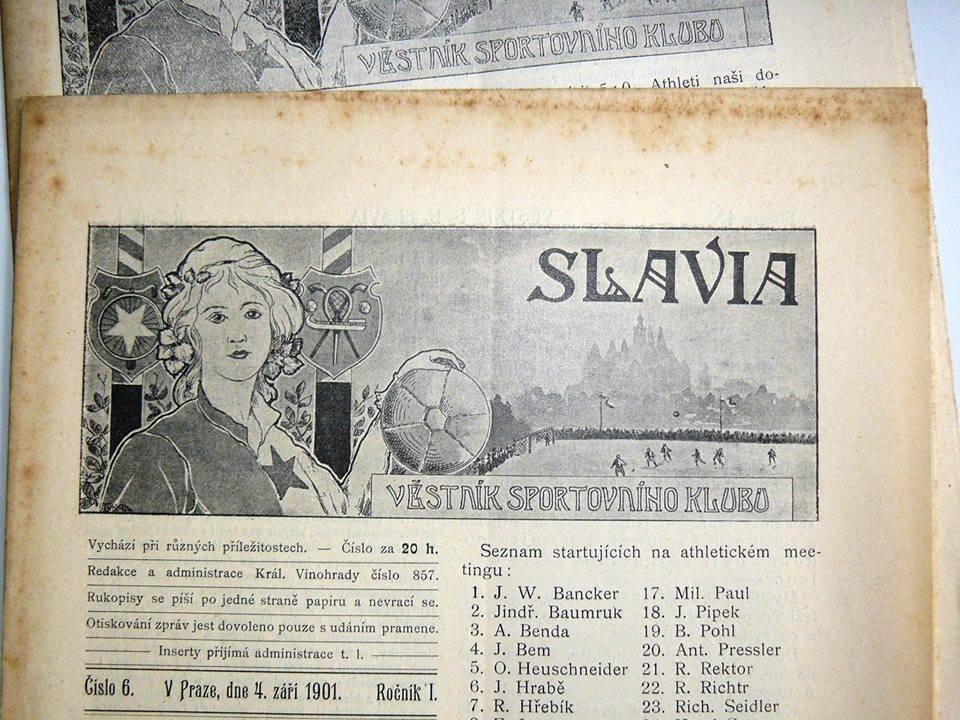Origins of the club
Where does our name come from?
“Sláwa”, an ancient Slavic goddess, protector of harvest and the territory, was known amongst scholars as “Slavia”. But how did our club adopt her name?
Since the 1848 revolution, Czech youths formed the Literary and Rhetoric Club and started to advocate for the rights of the Slavs, who constituted a significant ethnic minority in the Austro-Hungarian Empire. They claimed allegiance to a Czech patriotic writer, journalist, poet and politician Karel Havlíček Borovský the next year. The motto they placed as headers on their papers read “Our colours, red and white – my legacy, honesty and strength!” (Barva naše, červená a bílá – dědictví mé, poctivost a síla!)
These heraldic colours of Czech kings gradually gained the support of more and more enthusiastic students from Slavonia (today’s Croatia and Serbia) who came to Prague for their studies. The goddess of harvest and the territory was highly esteemed in Slavonia since the Roman Empire when the region was called Panonia and the local name of the goddess, Sláwa, was transcribed into Latin – as Slavia.
The territory occupied by the Slavs was huge and no other ethnic group managed to settle as large a space in Central and Southern Europe and Russia. The Czechs were delighted and proud to hear that all of this land was our land, Slavic land! Slavic settlers brought not only this pride but also many traditions (music, dress, customs), legends and myths. The pan-Slavic five-pointed star standing on the top became a symbol.
Over time, the Literary and Rhetoric Club renamed itself as Slavia and organized readings of patriotic works. The students form 1848 were active in looking for their successors and as early as 1880, we can find names and associated families that were later involved in establishing the sports club which started with cycling and gradually added other sports. The sports club adopted not only some of the rhetoric club rules but also the symbols: the red and white colours, the five-pointed star standing on the top.
A picture of the Goddess Slavia by a Czech Art Nouveau artist Alfons Mucha was depicted on the very first Czechoslovak 100 Crown banknote from 1919. We know that Mucha did not particularly research mythology and that it was Josephine Crane, a daughter of the first US Ambassador to Czechoslovakia, who stood as the model. However, it seems that there were no images of the goddess produced prior to Mucha’s work. Slavia had been only described previously and never depicted.
BULLETIN

100 CROWN BANKNOTE

Alfons Mucha originally painted the Goddess Slavia for a poster of the insurance company Slavia. The painting also appeared later on banknotes of the newly formed Czechoslovakia.
OATH AT THE FEET OF SLAVIA

ALFONS MUCHA’S PAINTING – GODDESS SLAVIA

IN THE BEGINNIG WAS THE BICYCLE

The first photo of Slavia founders from the newspaper Národní listy. The first chairman Jaroslav Hausmann in the middle. Photo: Slavia archive

The founders of our club in 1893 – the University Cycling Club Slavia. This is the first time we can see the Slavia flag, the first memorabilia of our club. The star points to the top in the picture but points to the bottom when turned by 90 degrees (such as on the pole). The star appeared on football shirts for the first time in 1896. Photo: Slavia archive

The oldest photo of Slavia from 1898. Back then, we still had to rent a place at Letná, ca 200 meters from the future stadium. First row from the top in the middle is the goalkeeper, the oldest one of seven Vosátka brothers, defenders Stöckel and Strádal stand next to him. The middle row from the left: midfielders Pressler, Hrabě, Krýž. The bottom row from the left: forwards Moučka, Setzer-Bloomer, the captain Freja, Kindl and Heuschneider (who later accepted a Czech surname of Hajský). Photo: Slavia archive

Slavia for the first time as the national team in 1899. Taking a Spartan goalkeeper Prokop on board for this occasion (black shirt with an “S” on the chest), Slavia played a game between Prague and Vienna (2:2). Both goals were scored by Setzer who also used the surname Bloomer as a tribute to the English football professional.

Opening of the new pitch with stands on 15 September 1901. The first game was a friendly with Allemanis Pforzheim which ended 15:2. Only a month later a former Slavia captain was elected the first official chairman of Czech football. Photo: Slavia archive

In 1903, Slavia welcomed striker Jan Košek to the club, who became the first internationally acclaimed Czech football player. Top row from the left: A. Pressler, Hrabě, Hejda, Dr. Práchenský, Žabokrtský, Veselý. Middle row from the left: Krummer, J. Benda, Setzer-Bloomer, Košek. Bottom row: Baumruk, Vaněk.




